Moderate overlap front: original test
Rating applies to 2010-14 models
Tested vehicle: 2010 Ford Mustang GT 2-door
The Ford Mustang was re-engineered and restyled for the 2010 model year. Note that these ratings apply only to the Mustang coupe and not to the convertible.
| Evaluation criteria | Rating |
|---|---|
| Overall evaluation | |
| Structure and safety cage | |
| Driver injury measures | |
| Head/neck | |
| Chest | |
| Leg/foot, left | |
| Leg/foot, right | |
| Driver restraints and dummy kinematics | |

Action shot taken during the frontal offset crash test.

The dummy's position in relation to the steering wheel and instrument panel after the crash test indicates that the driver's survival space was maintained very well.
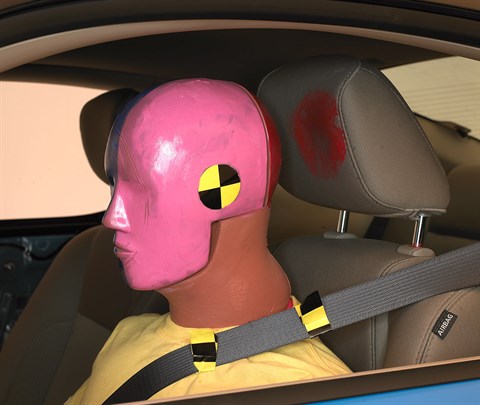
Dummy movement was well controlled. During rebound, the dummy's head hit only the head restraint, as indicated by smeared greasepaint.
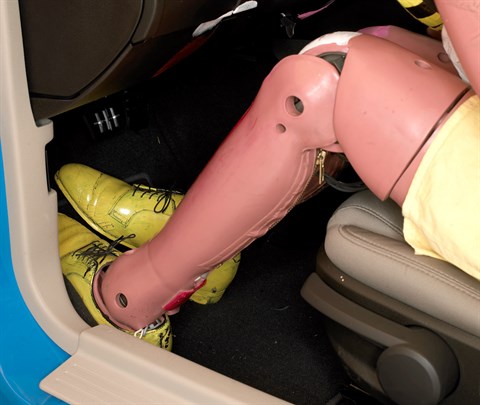
Intrusion into the driver's space was minimal, and all leg and foot injury measures were low.
Measures of occupant compartment intrusion on driver side
| Evaluation criteria | Measurement |
|---|---|
| Test ID | CEF0914 |
| Footwell intrusion | |
| Footrest (cm) | 5 |
| Left (cm) | 7 |
| Center (cm) | 8 |
| Right (cm) | 7 |
| Brake pedal (cm) | 2 |
| Instrument panel rearward movement | |
| Left (cm) | 0 |
| Right (cm) | 0 |
| Steering column movement | |
| Upward (cm) | 4 |
| Rearward (cm) | 2 |
| A-pillar rearward movement (cm) | 2 |
Driver injury measures
| Evaluation criteria | Measurement |
|---|---|
| Test ID | CEF0914 |
| Head | |
| HIC-15 | 159 |
| Peak gs at hard contact | no contact |
| Neck | |
| Tension (kN) | 0.9 |
| Extension bending moment (Nm) | 35 |
| Maximum Nij | 0.33 |
| Chest maximum compression (mm) | 26 |
| Legs | |
| Femur force - left (kN) | 1.8 |
| Femur force - right (kN) | 0.9 |
| Knee displacement - left (mm) | 3 |
| Knee displacement - right (mm) | 1 |
| Maximum tibia index - left | 0.31 |
| Maximum tibia index - right | 0.40 |
| Tibia axial force - left (kN) | 1.3 |
| Tibia axial force - right (kN) | 1.7 |
| Foot acceleration (g) | |
| Left | 57 |
| Right | 47 |
Side: original test
Rating applies to 2010-14 models
Tested vehicle: 2010 Ford Mustang GT 2-door with standard front seat-mounted combination head and torso airbags
The Ford Mustang was re-engineered and restyled for the 2010 model year. Note that these ratings apply only to the Mustang coupe and not to the convertible.
| Evaluation criteria | Rating |
|---|---|
| Overall evaluation | |
| Structure and safety cage | |
| Driver injury measures | |
| Head/neck | |
| Torso | |
| Pelvis/leg | |
| Driver head protection | |
| Rear passenger injury measures | |
| Head/neck | |
| Torso | |
| Pelvis/leg | |
| Rear passenger head protection The dummy's head was hit by the interior side trim panel beneath the rear side window and then by the pillar behind the window. According to Ford, both surfaces satisfy the federal standard to provide some protection for occupants' heads. |
|

View of the vehicle and barrier just after the crash test.
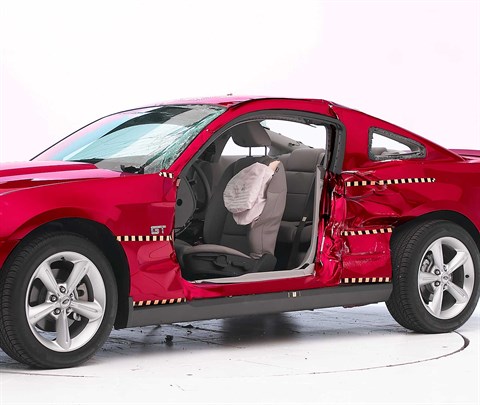
View of the vehicle after the crash with the door removed, showing the side airbag and damage to the occupant compartment.
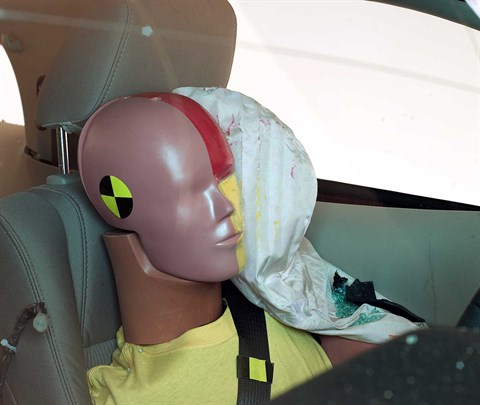
The driver dummy's head was protected from being hit by hard structures by the side airbag.
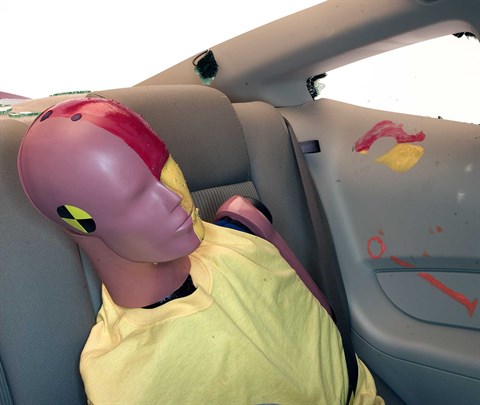
Smeared red and yellow greasepaint shows where the dummy's head was hit by the interior side trim panel.
Measures of occupant compartment intrusion on driver side
| Test ID | CES0922 |
|---|---|
| B-pillar to longitudinal centerline of driver's seat (cm) | -23.0 |
| Negative numbers indicate the amount by which the crush stopped short of the seat centerline. | |
Driver injury measures
| Evaluation criteria | Measurement |
|---|---|
| Test ID | CES0922 |
| Head HIC-15 | 297 |
| Neck | |
| Tension (kN) | 0.8 |
| Compression (kN) | 0.8 |
| Shoulder | |
| Lateral deflection (mm) | 42 |
| Lateral force (kN) | 1.5 |
| Torso | |
| Maximum deflection (mm) | 37 |
| Average deflection (mm) | 30 |
| Maximum deflection rate (m/s) | 3.62 |
| Maximum viscous criterion (m/s) | 0.60 |
| Pelvis | |
| Iliac force (kN) | 0.7 |
| Acetabulum force (kN) | 2.4 |
| Combined force (kN) | 3.0 |
| Left femur | |
| L-M force (kN) | 0.4 |
| L-M moment (Nm) | 181 |
| A-P moment (Nm) | 70 |
Passenger injury measures
| Evaluation criteria | Measurement |
|---|---|
| Test ID | CES0922 |
| Head HIC-15 | 796 |
| Neck | |
| Tension (kN) | 1.6 |
| Compression (kN) | 0.2 |
| Shoulder | |
| Lateral deflection (mm) | 49 |
| Lateral force (kN) | 1.1 |
| Torso | |
| Maximum deflection (mm) | 40 |
| Average deflection (mm) | 28 |
| Maximum deflection rate (m/s) | 4.63 |
| Maximum viscous criterion (m/s) | 0.69 |
| Pelvis | |
| Iliac force (kN) | 2.5 |
| Acetabulum force (kN) | 1.0 |
| Combined force (kN) | 3.5 |
| Left femur | |
| L-M force (kN) | 0.5 |
| L-M moment (Nm) | 60 |
| A-P moment (Nm) | 21 |
Head restraints & seats
Seat type: Power leather seat with 4-way head restraint manufactured after July 2011
| Overall evaluation | |
|---|---|
| Dynamic rating | |
| Seat/head restraint geometry |
| Seat type | Power leather seat with 4-way head restraint manufactured after July 2011 |
|---|---|
| Geometry | |
| Backset (mm) | 14 |
| Distance below top of head (mm) | 34 |
| Seat design parameters | |
| Pass/fail | Pass |
| Max T1 acceleration (g) | 11.3 |
| Head contact time (ms) | 70 |
| Force rating | 1 |
| Neck forces | |
| Max neck shear force (N) | 52 |
| Max neck tension (N) | 689 |
About the head restraint & seat test
Currently, IIHS tests apply only to front seats.
